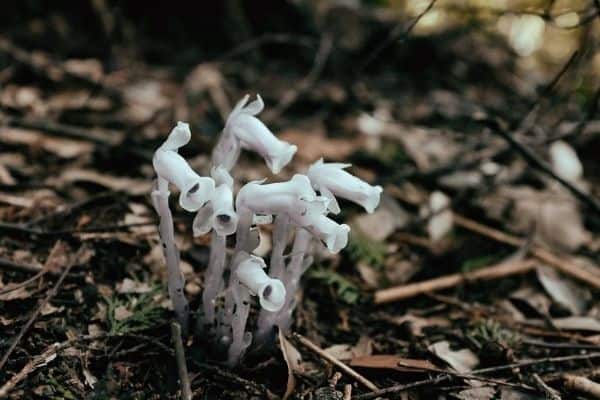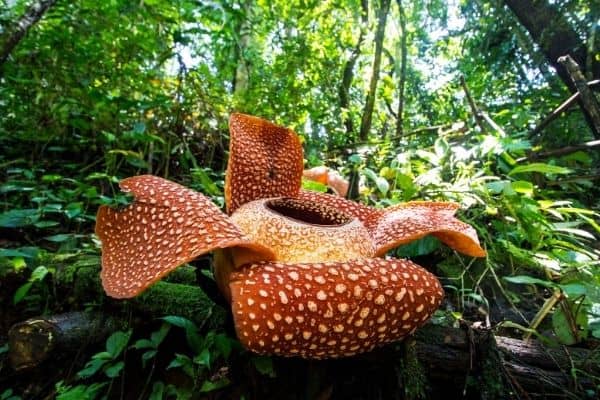
A green plant uses chloroplasts, which actually contain a green pigment called chlorophyll, to convert light energy into energy plants can use (sugar). But how do non-green plants make their food?
A non-green plant can make its own food by the use of sunlight to synthesize nutrients from carbon dioxide and water. If a plant is not able to make its own food, it can derive some or all of its nutritional requirements from other living plants and act as a parasite.
In this article, you will discover exactly how non-green plants obtain nutrients in order to survive.
Contents
Food Processing in Non-Green Plants
Almost all types of plants are green. We see their diversity every day everywhere we go. Every plant is known to have chlorophyll, a green pigment that is used for photosynthesis. Photosynthesis is the process by which plants get energy from sunlight and convert it into nutrients. These nutrients will serve as the food for the plant supporting its growth and general health. Below is a formula for photosynthesis.

Surprisingly, not every plant is green. Some plants have different colors like red, white, or yellow. However, the chlorophyll that makes plants green is a necessity for the process of photosynthesis. Plants need photosynthesis to produce energy in the form of sugar.
If some plants have no chlorophyll in their tissues, how do they create their food? There are various ways for non-green plants to create their food and continue thriving in our environment.
Here is how they do it.
Chlorophyll is Masked by Other Pigments
Chlorophyll pigment is always green but plant leaves and stems aren't always green because they have many pigments other than chlorophyll.
These plants still contain chlorophyll but are only in the disguise of a different color. They are hidden under pigments that are different from the green. Some plants may be having a purple pigment and make the appearance of the plant purple. But despite its different color, photosynthesis might still be happening inside since it was just a unique type of chlorophyll. There are 6 Photosynthetic pigments that can be present in chloroplasts, these are:
- Carotene: an orange pigment
- Xanthophyll: a yellow pigment
- Phaeophytin a: a gray-brown pigment
- Phaeophytin b: a yellow-brown pigment
- Chlorophyll a: a blue-green pigment
- Chlorophyll b: a yellow-green pigment
These accessory pigments can be other chlorophylls like the ones named above or they can be completely different pigments with completely different colors, including the following types of common pigments: anthocyanins, aurones, chalcones, flavonols, proanthocyanidins, betacyanins, and betaxanthins.
You may be surprised to learn that each leaf has small amounts of other colors in it year-round, even if we can't see them.
During the spring and summer, chlorophyll overpowers the other colors, and all we see is green.
During the fall and winter, there is less light and less chlorophyll is being made. With less chlorophyll to give the leaf its vibrant green color, we begin to see the other colors, such as orange, yellow, and red, which have been there all along.

The Wavelength of Light Changes The Color of the Leaf
Aside from this, it is also possible that we see the different wavelengths of light as color. All colors in the spectrum are visible in the sunlight. When light hits an object, colors are absorbed, while others are reflected.
For example, we see green leaves because green is the only color in the spectrum of light that chlorophyll does not absorb, so the leaf looks green because that is light is reflected in our eyes instead of being absorbed by the leaf.
Chlorophylls and carotenoids are the two major classes of photosynthetic pigments found in plants and algae; each class has multiple types of pigment molecules.
Each type of pigment can be identified by the specific pattern of wavelengths it absorbs from visible light, which is the absorption spectrum. Chlorophyll a absorbs light in the blue-violet region, while chlorophyll b absorbs red-blue light. Neither a nor b absorb green light; because green is reflected or transmitted, chlorophyll appears green. Carotenoids absorb light in the blue-green and violet region and reflect the longer yellow, red, and orange wavelengths.

On the other hand, although chlorophyll is always seen as green, there are other pigments that leaves can possess. Sometimes, the color of the leaves is influenced by external factors. For instance, a reddish pigmented plant may be caused by its self-defense mechanism from green plant-eating animals. Hence, disguising itself in different colors.
We can say that different pigments reflect a different kind of colors, for example, the carotenoids found in fruit:
- The red of a tomato - lycopene
- The yellow of corn seeds - zeaxanthin
- The orange of an orange peel - β-carotene
In these cases, a plant with a different color can still make its own food with the help of photosynthesis.
A Lack of Chlorophyll in Leaves
Some plants, like some types of Hosta like the Plantain lily, has white leaf borders. This indicates that there is a lack of chlorophyll at the sides of the leaf. The rest of the leaf has enough chlorophyll and remains green.

Photo by: Forest Starr & Kim Starr
The plants that have leaves with white spots often have adaptation strategies, such as large leaves, that allow the green areas of the leaves to produce sufficient amounts of energy to support the plant. These plants still make their own food, but only from the green parts of the leaves that contain enough chlorophyll.
A couple of other plants that have leaves with large areas of white and green are:
- Mock oranges
- Ivy
- Hypoestes phyllostachya
If you like this type of content, check out: What is Emasculation In Plants
The Non-Green Plant is a Parasitic Plant
It appears that some plants that don't have a green color, don't have any chlorophyll (a green pigment that is used within the plant to undergo photosynthesis). They don't have chlorophyll of their own and need to steal the sugar and water from other plants so that they can have their food supply.
Parasitic plants can be holoparasites, with virtually no chlorophyll and thus completely parasitic. But they can also be half parasitic (hemiparasites) - in this case, only a part of the food they obtain is made by themselves.

Because these plants don't undergo photosynthesis themself and thus don't have chlorophyll, they appear in different colors.
They steal food from other plants or fungi using specialized roots called “haustoria”. At times, all they need is to tap nearby plant roots and get their supply of water and sugar and they will survive. One example of this is the Hydnora africana.
H. africana is a type of parasitic plant that steals or eats other plants for energy. This type of plant cannot perform photosynthesis on its own. Instead, it absorbs nutrients from outside sources. In particular, it parasitizes the fungi that received carbohydrates from the roots of trees.
Some other examples of plants that don't have chlorophyll and are parasitic are:
The Ghost Plant (Monotropa uniflora)

Image by: Joshua Hurd
This plant survives by borrowing nutrients from certain fungi, trees, and decaying plant matter. It doesn't produce its own food, because the plant doesn't have any chlorophyll to photosynthesize. This is why the Ghost plant is able to grow in the darkest of forests.
This plant grows in most regions of the United States and is also found in northern parts of South America.
The Devils Guts (Cuscuta campestris)

Image by: Fabelfroh
The Cuscuta has little to no chlorophyll making it unable to undergo photosynthesis. For this reason, it can't make its own food.
To survive and take in nutrients, this parasitic plant wraps itself around other plants and grows into their stems, leaching sugars and water.
The Corpse Lily (Rafflesia arnoldii)

Image by: SofianRafflesia
The Corpse Lily holds the Guinness World Record of the tallest bloom, which was measured 10 feet 2.25 inches (3.1 meters) tall. It attracts flies with the smell of rotten flesh in order to pollinate itself. This is how it has earned its name "corpse flower" or "corpse lily".
This parasitic plant obtains all its nutrients and water from plants of the genus Tetrastigma (a vine member of the grape family). They set up buds in the roots and stems of these plants and remain closed until they have leached enough nutrients to flower.
Also check out: How do Plants Get Their Nitrogen?



Leave a Reply